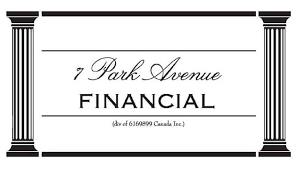|
Working Capital Solutions That Move at Business Speed
Unlock Your Business Potential with Strategic Cash Flow Financing
You Are Looking for Working Capital Cash Flow Solutions!
You've arrived at the right address! Welcome to 7 Park Avenue Financial
Financing & Cash flow are the biggest issues facing business today
Unaware / Dissatisfied with your financing options?
Call Now! - Direct Line - 416 319 5769 - Let's talk or arrange a meeting to discuss your needs.
Email - sprokop@7parkavenuefinancial.com

Smart Canadian entrepreneurs are revolutionizing their cash flow management through strategic working capital financing solutions.
7 Park Avenue Financial originates business financing solutions for Canadian Businesses – We offer Working capital cash flow financing solutions – Save time, and focus on profits and business opportunities
7 Park Avenue Financial: “Canadian Business Financing with the intelligent use of experience”
Working Capital Cash Flow Financing
Working capital Cash Flow - What is it?
Simply a measure of a company’s financial and financial health. It’s cash in versus cash out over a given period!
To calculate cash flow, you can use various methods and formulas, such as evaluating operating cash flow derived from net income and considering the impact of changes in working capital.
That’s one of the better definitions we’ve seen lately, as it relates directly to your cash flow statement and the amount of cash shown in your financial statements. And could that emphasis on ‘financial health’ be any more accurate? - We don’t think so.
Canadian business owners and financial managers want to… wait a minute, need to!… understand cash-flow concepts and those critical changes in working capital. By the way, cash flow solutions wouldn’t be wrong either, and we’ll shortly be identifying some of those!
DON'T LET THE CASH FLOW CRUNCH STRANGLE YOUR BUSINESS!
Even large companies face cash flow gaps in day-to-day funding, whether due to slow a/r, seasonality in the business, or unexpected expenses.
Let the 7 Park Avenue Financial team show you real-world working capital cash flow financing solutions when traditional financing can't
DEFINITION OF WORKING CAPITAL
Working capital is a financial metric measuring a company’s liquidity and ability to meet short-term obligations.
Essentially, it is the difference between a company’s current assets—such as cash, accounts receivable, and inventory—and its current liabilities, like accounts payable and short-term debt.
Working capital is crucial for funding day-to-day operations and ensuring that a business can cover its immediate expenses, such as paying employees and suppliers and meeting interest payments and taxes. A healthy working capital position indicates that a company is well-managed and financially stable.
WHY YOU NEED TO MAINTAIN WORKING CAPITAL FINANCING STRENGTH
Working capital financing is the key to growth. Understanding the relationship between capital and cash flow is crucial, as working capital represents a company's current financial state while cash flow tracks income and expenses over time.
Changes in working capital can significantly impact cash flow, underscoring the importance of both concepts for better financial decision-making.
Managing a company's working capital is essential for funding daily operations and analyzing short-term and long-term financial activities.
RELATIONSHIP BETWEEN CASH FLOW AND WORKING CAPITAL
Cash flow and working capital are two vital financial metrics closely intertwined. Cash flow measures the amount of cash moving in and out of business over a specific period while working capital represents the difference between current assets and current liabilities.
A company’s cash flow directly impacts its working capital. For instance, a decline in revenue leading to negative cash flow can reduce working capital, making it challenging to meet short-term obligations.
Conversely, a positive cash flow boosts working capital, providing the necessary funds to support operations and growth. Understanding the relationship between cash flow and working capital is essential for maintaining a company’s financial health.
WHY WORKING CAPITAL FINANCE?
Cash flow financing will help you build your business, purchase inventory to fulfill orders quickly, launch growth projects and expand into new markets.
Understanding how much cash moves in and out of business over a specific time frame is crucial for maintaining sufficient cash to meet obligations and support growth.
Funds can be used for several purposes, such as improving profitability, paying suppliers upfront with special discounts, and covering other large expenses.
Negative working capital, where current liabilities exceed current assets, can indicate trouble paying suppliers and creditors, necessitating reliance on borrowing or stock issuances to finance operations. It suggests a lack of liquidity and potential long-term financial instability.
BUSINESS GOALS AND THE COMPETITION
The goal of any business, regardless of industry or size, is to grow in its products and services.
Net working capital, including current assets and liabilities, is crucial for understanding a company's short-term financial health. However, it can be difficult work, and many entrepreneurs face this challenge all over the country. This means more competition among companies looking for cash flow solutions than ever before.
Operating cash flow is significant in assessing a company's financial health as it measures liquidity and operational efficiency.
The challenge? Keep up on payrolls and other overhead expenses in your company’s cash flow because there isn’t enough money from sales and collections into their businesses.
We all agree that cash flow financing forces the business owner to address some key issues, i.e. dealing with banks, managing operating expenses, borrowing from other independent finance firms, etc.
ASSET TURNOVER AND ACCOUNTS RECEIVABLE IS THE KEY
When we sit down with clients who bring in their balance sheet and income statement, it's clear that there is a true misunderstanding often... in the business owner's eyes about what that income statement is telling us. Those changes in the balance sheet should be focused on instead, particularly our working capital accounts, receivables, and inventory.
Are there real-world Canadian-made solutions for managing cash flow financing, and what type of 'loan' best suits your cash flow needs or crisis!?
When you think of it, it all comes down to managing your billings, aka receivables, granting terms to clients, and of course, managing payables which many business owners omit in their 'cash flow analysis.'
FOCUS ON QUALITY OF EARNINGS
We can also add that a great concept we use is often overlooked: the quality of earnings.
Simply speaking, net profits don’t always (in fact, they rarely) equal cash flows. Working capital and free cash flow are critical metrics to assess a company's financial health.
A quick example would be giving customers extended terms and booking more extensive sales and profits… for a while! The closer you can bring those two together at a reasonable financing cost, the more you will solve working capital cash flow financing.
So, great job so far on all the technical jargon, right? Not what you were looking for?!
Let’s jump into the real world, our favourite place. We’re identifying 5 working capital cash flow financing ‘loan’ techniques. And guess what? Four of them aren’t ‘loans’ per se.
STRATEGIES FOR MAINTAINING A POSITIVE CASH FLOW
Maintaining a positive cash flow is crucial for a company’s financial health and sustainability. Here are some effective strategies to achieve this:
-
Manage Accounts Receivable and Accounts Payable: To improve cash flow, promptly send invoices and ensure timely payment collection. Implementing shorter payment terms, late fees, and early payment discounts can also be beneficial.
-
Optimize Inventory Management: Keeping inventory levels low helps avoid tying up too much cash in stock, thereby improving cash flow.
-
Reduce Expenses: Cutting unnecessary expenses can significantly enhance cash flow. Regularly review and eliminate non-essential costs.
-
Invest in Cash-Generating Assets: To boost cash flow, consider investing in assets that generate cash, such as accounts receivable financing or invoice factoring.
-
Monitor Cash Flow Regularly: Reviewing cash flow statements regularly helps identify areas for improvement and ensures that any issues are addressed promptly.
By implementing these strategies, businesses can maintain positive cash flow and ensure they have the necessary funds to support operations and growth.
UNDERSTANDING NEGATIVE CASH FLOW
Negative cash flow occurs when a company’s expenses exceed its revenue, decreasing cash and cash equivalents. This situation can signify financial distress and difficulties meeting short-term obligations.
Understanding the causes of negative cash flow is crucial for taking corrective action.
Common causes include:
Declining sales
High operating costs
Poor accounts receivable management
Excessive inventory.
Addressing negative cash flow promptly is essential to prevent long-term financial issues and ensure the company’s financial health.
5 REAL-WORLD SOLUTIONS TO THE WORKING CAPITAL CHALLENGE
Finance textbooks talk about the working capital formula - the difference between current assets and current liabilities - but textbooks can fund your business.
Negative working capital, where current liabilities exceed current assets, can indicate trouble paying suppliers and creditors, necessitating borrowing or stock issuances to finance operations. It suggests a lack of liquidity and potential long-term financial instability.
So, let’s examine some real-world available solutions for business capital.
If you want to fix, improve, or change your cash flow financing, consider one of the following -
A/R Financing / Confidential receivable financing
Cash working capital term loan - injection of permanent working capital into your firm,
Asset-based Lending / ABL facility - the non-bank business line of credit
Junior working capital facility - short-term working capital loans/mezzanine financing
Merchant cash advances
Inventory and purchase order financing
3 Uncommon Takes:
- Using working capital financing as a negotiating tool for better supplier terms
- Leveraging cash flow financing to create a counter-seasonal business strategy
- Utilizing financing data to identify operational inefficiencies
DID YOU KNOW?
- 82% of business failures are attributed to poor cash flow management
- Average small business has 27 days of cash buffer
- 60% of Canadian SMEs seek working capital financing annually
- Approval rates for alternative working capital financing are 15-20% higher than traditional loans
- Companies using working capital financing report 23% faster growth rates
KEY TAKEAWAYS
-
Quick Access to Capital transforms accounts receivable into immediate funding, enabling rapid business response to opportunities.
-
Flexible Repayment aligns with your actual cash flow patterns, reducing financial stress.
-
Revenue-Based Structure means payments adjust to your business performance
-
Credit Requirements focus more on cash flow strength than traditional credit metrics
-
Seasonal Adaptation allows for variable payment schedules matching your business cycles
-
Net Working Capital is crucial for understanding a company's short-term financial health. It is calculated by subtracting current liabilities from current assets, excluding cash and debt. Positive net working capital indicates a company can cover its short-term obligations, while negative net working capital suggests potential liquidity issues.
CONCLUSION - WORKING CAPITAL POSITIVE CASH FLOW GUIDELINES IN CANADA
Any of those solutions will improve your cash flow. Want information on what they are, how they work, what they cost and where to get them...
Call 7 Park Avenue Financial, a trusted, credible, experienced Canadian business financing advisor.
FAQ
What makes working capital cash flow financing different from traditional loans?
-
Faster approval process than bank loans
-
Based on business performance rather than credit score
-
Flexible repayment terms matching cash flow patterns
-
No fixed monthly payments
-
Can scale with business growth
How does this financing solution help with seasonal business fluctuations?
-
Provides funding during low-revenue periods
-
Adjusts payments based on business cycles
-
Enables inventory purchases ahead of peak season
-
Maintains steady cash flow year-round
-
Supports strategic growth planning
What impact does this have on my business's growth potential?
-
Enables quick response to opportunities
-
Supports inventory expansion
-
Allows for equipment upgrades
-
Facilitates hiring during growth phases
-
Provides competitive advantage through better cash flow
Can this financing help improve vendor relationships?
-
Enables early payment discounts
-
Strengthens supplier negotiations
-
Maintains consistent payment schedules
-
Builds credibility with vendors
-
Supports supply chain optimization
What flexibility does this solution offer compared to traditional financing?
-
Adapts to revenue fluctuations
-
No fixed payment schedules
-
Quick access to additional funds
-
Minimal paperwork for renewals
-
No collateral requirements typically needed
How do lenders evaluate my business for working capital financing?
-
Review of recent bank statements
-
Analysis of cash flow patterns
-
Assessment of accounts receivable quality
-
Evaluation of business model sustainability
-
Consideration of industry factors
What happens if my revenue fluctuates significantly?
-
Payment structures adjust with revenue
-
Flexible terms accommodate business cycles
-
Regular reviews to adjust facility size
-
Options to modify terms as needed
-
Proactive communication with lender maintains flexibility
Can I combine this with other financing solutions?
-
Integration with existing bank relationships possible
-
Complementary use with term loans
-
Strategic combination with equipment financing
How does working capital cash flow financing calculate repayment terms?
-
Based on percentage of monthly revenue
-
Considers historical cash flow patterns
-
Factors in seasonal fluctuations
-
Adjusts to business performance
-
Reviews payment capacity regularly
How does working capital financing differ from traditional loans?
Working capital financing focuses on business cash flow rather than credit scores or collateral. It offers flexible repayment terms that align with revenue patterns, typically provides faster approval, and can adjust to business seasonality. Unlike traditional loans, it often requires no personal guarantees.
What businesses benefit most from working capital financing?
Businesses with strong cash flow but irregular payment cycles benefit most from working capital financing. This includes seasonal operations, B2B companies with long payment terms, growing companies with high inventory needs, and businesses with significant accounts receivable.
What documentation is needed for working capital financing? Essential documentation includes:
-
Last 6 months of bank statements
-
Accounts receivable aging report
-
Recent tax returns
-
Financial statements
-
Cash flow projections
-
Business registration documents
Will this affect my existing banking relationships?
Working capital financing often complements traditional banking relationships. Many businesses maintain both funding sources.
How do working capital changes affect cash flow in my business?
Working capital is the difference between a company's current assets and its short-term liabilities. A firm with positive working capital has more of one than the other, meaning it can fully cover short-term expenses due in 12 months or less. Having an excessive amount for too long might indicate financial weakness on behalf of management, which is not managing their finances well enough to meet obligations when urgent demands arise.
What is a cash flow loan?
Cash flow loans are a type of loan, usually structured as term debt, that doesn't require any business or personal assets to be given as collateral. Instead, bankers usually grant the cash-based primarily on past and forecasted cash flows for your company's finances.
Cash flow loans are long-term unsecured loans based on your business's past and forecasted cash flows. These types of loans usually have an amortization period ranging from two to five years. Commercial lenders look at many different factors when deciding how much money a firm can borrow, including interest rates, whether or not there is additional collateral available, and normal enterprise risk associated with lending funds.
If you have a healthy cash flow and good asset turnover, banks and commercial lenders will be willing to give your business the money needed. Solid asset turnover around accounts receivable, accounts payables ( current liabilities ), and inventory sell-through demonstrates capable management of assets and sales.

' Canadian Business Financing With The Intelligent Use Of Experience '
STAN PROKOP
7 Park Avenue Financial/Copyright/2024

Stan Prokop is the founder of 7 Park Avenue Financial and a recognized expert on Canadian Business Financing. Since 2004 Stan has helped hundreds of small, medium and large organizations achieve the financing they need to survive and grow. He has decades of credit and lending experience working for firms such as Hewlett Packard / Cable & Wireless / Ashland Oil
|